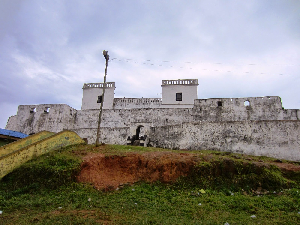 The Fort Saint Anthony at Axim is the largest in Ghana
The Fort Saint Anthony at Axim is the largest in Ghana
The story of Governor J. M. Gomez and how he tragically lost his life out of excitement that his wife, who he had not seen for a very long time, was approaching the beach, was captured in a blog post by therealetsey.wordpress.com on August 9, 2015.
According to the accounts the blogger received from the caretaker of the Fort Saint Anthony at Axim, the largest in Ghana, John Ackah, Gomez’s excitement was paradoxically shortened when he tripped on the staircase and tumbled to his death.
He described it as follows, “With a telescope in hand, focused on the approaching boat on the sea, whose bed was just about some five steps away from the giant walls of the Fort, he kept descending the steps of his bedroom, which was very high up, overlooking the entire compound.
“Still gazed at the sea and with a beaming smile gradually drawing on his bearded face by now, he could see his wife on board, with the enthusiasm that characterised his descension only getting the better of him so much that he missed his steps, tumbling so hard to the ground right in front of the slaves in the open space where they were lined up daily to receive some fresh air.
“To these unsuspecting slaves bound in chains, that fall with his legs up in the air was just a rare spectacle to make them laugh out their sorrowing hearts out so hard, so much that they only looked on innocently as death carried his soul away.”
For J. M Gomez’s wife, when she eventually came to shore, her excitement was replaced with great sorrow, as she was greeted with the corpse of her husband, who she had travelled months to come see in the then Gold Coast.
Now over 500 years old, Fort St. Anthony was built by the Portuguese from 1503 to 1515 as a missionary residence for the first Whites who came to this part of the world. The place was built purely of cement, clay, stones and lime powder.
With four dungeons only (two each for both males and females), Fort St. Anthony used to house as many as 280 slaves, with only 95 being females. During the day, the slaves were all marched to an open space, standing on their feet and under the scorching sun, to take fresh air.
In the female dungeons, there were 45 inmates each with an inner and outer dungeon, where those who wished to sleep in the inner one (which was usually hot) did so lying down while those in the outer slept standing with some fresh air available to them from outside.
For the men, they were 40 in each dungeon on the average and 50 in extreme cases.
With a large storeroom used to store all their foodstuffs, the colonial masters would eat nothing from the community. Not even water from the large well they had sunk was served them because they believed that it contained worms.
And of course, to avoid suspicions and protect themselves, the entire fort was lined with cannons, ready to fire at anything, even a tree that was shaking in a distance, as they imagined their enemies could be hiding in them.
For this reason, it was highly difficult for the locals to even go close to it.
Giving a description of this fort, John Ackah told the blogger how the platforms that held the upper floors of the building were purely made out of sand and stone fillings.
He said this was a measure to protect the fort from any reprisal bomb attacks that could collapse their walls.
And by the time the indigenes became aware of the real intentions of the Whiteman in their community, they became very incensed and cheated. For this, they decided to rebel against them, fighting them at the least opportunity.
One of such brave hearts, King Badu Bonsu II from Butre, is documented to have single-handedly killed over 270 Dutch. No wonder when he was finally captured by Maj. Gen. Jan Verveer in 1838, he was decapitated and his head sent to the Netherlands.
AE
